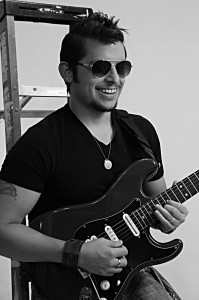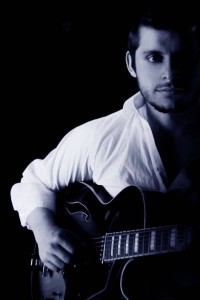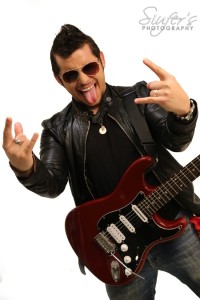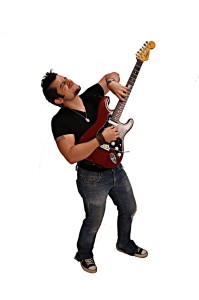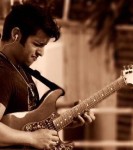
Camilo Velandia is one of the young up and coming guitarists on the scene today, with chops that span many genres and an already strong resume of people he’s worked with. We spoke on the phone right after he got back from a long tour with Julio Iglesias as his lead guitarist, a gig that does a lot to pay his bills and finance his ongoing study of improvisation and the guitar in general.
DP: Let’s start with letting people know the proper pronunciation of your name.
CV: Sure, it’s “ca-MILL-loâ€, the last name is pronounced just how it’s spelled, “ve-LAND-e-aâ€.
DP: Where were you born?
CV: I was born in Colombia in a city called Bogota.
DP: I know you live in Miami, FL now, how and when did you come over to the US?
CV: Well, my dad was a musician for years and played professionally. He moved to New York from Colombia and then he moved back down and that’s where he met my mom. So they had my sister and me and at one point, they decided, since everyone always said that the US has a bigger opportunity, to move to Miami. We had an aunt who was living here at the time, so it was a pretty easy transition for them I guess.
DP: And how old were you when you came to the US?
CV: I was 11, it was in ’99, I’m 26 now.
DP: So were you already playing guitar at that point?
CV: No, I started with keyboard. My dad was a pianist, and so ever since I was four he was teaching me… kind of against my will (both laugh). So, I always grew up around music and I had a really good ear, I was always singing harmony to records and I just thought that that was a normal thing to do. Then when I got to middle school I decided that I wanted to play violin because I didn’t want to play keys anymore. So I started playing violin, but a lot of my friends started guitar classes and they had something to talk about so I started doing that and my mom got me a teacher after she saw that I was really into it.
DP: So who were the first guitar players that made you go “wow, this is the instrument that I really want to play�
CV: Well, I used to be really into rock, so when I first started taking lessons with this guy, he turned me on to (Eddie) Van Halen, so I was like super into Van Halen. So I was into all the classic bands like Journey, Boston, Kansas, I used to like Iron Maiden too. And then I got into Yngwie Malmsteen, and my teacher was really a jazz guy so he said “maybe you should check out jazzâ€, so the first guy he turned me onto was George Benson, doing “On Broadwayâ€. So I transcribed the solo, and I really liked it and so he gave me more to transcribe, and then I got into (Pat) Metheny and all kinds of stuff and so that was how I got into jazz.
DP: So you transcribed the solo yourself? Your ears must have been GREAT to do that at that age!
CV: Yeah, I wouldn’t write it out or anything, I’d just play along. I didn’t do it because somebody told me to; I just like playing along with songs. A lot of times what I would learn was wrong and I would run into someone’s transcription and I’d go, “oh, that’s what that wasâ€.
DP: I know you do a lot of transcribing, I remember see on Facebook you playing your transcription of Michael Brecker’s solo on the Bird tune “Moose the Moocheâ€.
CV: Yeah, I did that and some other Michael Brecker things from the Brecker Bros – those Brecker things are always a pain (laughs).
DP: You know I was teaching at MI when Frank Gamble was there, and that’s how he developed his technique was finding a way to play the Brecker solos he was transcribing at tempo.
CV: Yeah, it’s a whole different thing!
DP: Yeah, putting stuff from other instruments on the guitar is a whole other bag of problem! Well, that brings up something I wanted to talk about: you and I are both left handed people playing the guitar right handed. I talk to right handed people playing right handed all the time that are asking on what to do to help their picking. What issues have you had to over come, or what solutions have you used to strengthen your picking?
CV: Well, I don’t know what to compare it to because I have never talked to a right handed person on what their issues were with their left hand. But a lot of the rock guys I listened to were doing a lot of speed picking and the teacher that I had had given me a lot of exercises for string skipping and alternative picking – I didn’t know anything about economy picking at that time. I used to do a lot of these Bach Inventions with a pick, and so I never really thought that I had a disadvantage of being right or left handed.  Then, sometimes, I would find a player doing a lot of really crazy stuff with their right hand, so at that point I started to look for excuses for myself as to why I couldn’t do it. (Laughs) Then I started to study with Jonathan Kreisberg. http://www.jonathankreisberg.com/  In my opinion, he’s like the best straight ahead guitar player now.  Composition-wise, a lot of things, he’s like one of those Kurt Rosenwinkle kind of guys – in my opinion, if he’s not the best, he’s definitely got the best technique of all of them. Which is funny, because he also comes from a rock background and now he’s like a super strict only straight ahead thing now, but his thing when I studied with him – he used to do all of these crazy string skipping things that I couldn’t do – I used to say “I probably can’t do that because I’m left handed†you know, and he was like “That’s B.S., that’s a stupid excuse†(both laugh). So ever since then I don’t give myself any excuses.
DP: So is he in Miami?
CV: He’s in New York, he plays with Dr. Lonnie Smith, and he has his own band. (If you want to see an example of Jonathan Kreisberg’s amazing technique and musicality with a whole set from the very great Dr. Lonnie Smith here’s a great video, Lonnie has his own very mystical approach to jazz: https://www.youtube.com/watch?v=ARvagv1FPoE)
DP: So other than Kreisberg, did you study formally?
CV: Yeah, I started with private lessons with this guy that my mom hired, and then I started taking a classical guitar class at high school. And I learned a lot of the classical literature like Francisco Tarrega and Villa-Lobos and all those guys from Spain and Brazil with real beautiful compositions. And the teacher we had in that class wasn’t really a guitar player, he was just a sax player that had a teaching gig, so he wasn’t really able to teach me proper technique but he would just say “learn this, learn this, learn that†and I just would. Then, I did go to college for a couple of semesters at Miami Dade College because I had a scholarship and I studied with this guy Tom Lippincott http://www.tomlippincott.com/ He’s a monster, and 8 string guitarist, he’s like a Ben Monder type of thing http://www.benmonder.com/ . He’s got all of these crazy voicings and beautiful chord solos, all that type of thing. He was a great teacher as well; a lot of guys that are great players don’t really know how to teach you the stuff they know. All the things he gave me were great exercises and I learned a lot doing that. Speaking of Ben Monder, he’s a guy that a lot of people haven’t listened to but he’s been around forever, the first time you listen to him you’ll be like blown away, the voicing stuff that he’s doing, I’ve never heard anybody else doing.
Then besides that I started doing a lot of top 40 gigs, which was cool because it kept me from just being a jazz player trying to play rock. So it got me to be able to play funk and jazz and R&B and everything – there’s really a broad range of music here in Florida, in Miami, because you have the church guys that are doing that music and the Latin guys doing that, and of course there’s a good crowd of American people that want to hear the classic rock and R&B.
So then I started playing for this girl and her boyfriend who was the MD (musical director) of the band was also the MD for Jon Secada. So there was an opening in that band and so he recommended me for that gig and that’s how I started touring. We did a lot of stuff in the States and South America and even Asia as well. The band was great and obviously Jon is a huge artist who has won lots of Grammys, but a lot of people don’t know that he actually went to school for jazz as well. He plays piano and he was super-cool with the band taking the songs out and adding changes and substitutions and all of that – not one time did he ever say, “No, don’t do thatâ€, you know?
DP: Wow, that’s amazing – that’s really unusual! (both laugh) So how long did you play with Secada?
CV: Well, I still am, actually, I have a gig next month – but I did it steady with him for maybe half a year. And then the Julio thing opened up and the keyboard player and drummer for Jon used to play with Julio – and there is a guy down here, Dan Warner, who is the biggest session guitarist here who played on everything, he played on the last Michael Jackson record. He did the Julio gig in the 90s for like 10 years. So they called him and he recommended me, and the MD for Julio had called another guy who also recommended me, so he called me and I jumped on that. So I did that for about eight months and then took a break and got back on the Secada then, and then went back with Julio. It’s been a little over three years now for these gigs.
DP: You play nylon and electric on that gig?
CV: Yeah, it depends on what mood he’s in, if we go to South America I always have an acoustic.
DP: And when you get back in town, what kinds of things do you do – sessions?
CV: Yeah, but I do sessions on the road as well because I always take a little portable recording rig. I have an Apogee Duet, and that’s actually what I used for the JGS video. So I use that to do recording sessions for people and do demos and write my own stuff, and when I am in town I have a little more sophisticated studio rig. And besides that, I do a lot of live gigs as well.
DP: Well, you have a very interesting sort of hybrid of styles going on in your playing – and speaking of that. One of the things that I know you use is hybrid picking, talk a bit about how you got into that and how you use it.
CV: Well, hybrid picking is a really huge thing and it’s hard to categorize it. When someone says to me hybrid picking, I either think of someone picking and also playing other notes with the middle finger on the right hand, or also something like Brett Garsed http://www.brettgarsed.com/ who uses a pick and then all his fingers – even his pinky – to pick notes. That, I can’t do. He takes it to a whole different level. The first time I ever saw somebody hybrid picking, I think, was Guthrie Govan http://www.guthriegovan.co.uk/ – everybody plays some notes with their middle finger, but when I saw this I said “this is probably not for meâ€â€¦but then I just started trying to work it in…because it has a certain sound, you know, the pick has a certain sound and the flesh of your finger has a certain sound. So I just started trying to work it into little licks – I started to use it a lot for Julio because he likes that Larry Carlton type of thing where you kind of pluck the strings and it gives it a certain poppy sound clean tone – he loves that. So it probably helped that I was doing that so much on the road and then I would go back to my hotel room and shed and it just sort-of snuck it’s way into my playing.
But I’ve always been trying to develop everything, I don’t want to be just a hybrid picker, or just an alternate picker, or just an economy picker. I want to be able to do everything. Steve Vai says, “don’t focus on your weaknesses, focus on your strengthsâ€, but I can’t feel like there’s something that I just can’t do.
DP: So you mentioned Pat Metheny and George Benson as influences as you were coming up, who would you say are the main guitar players that you listen to now?
CV: Well, it’s always changing, but in the beginning because I was coming from a non-jazz background, it was easier to listen to Benson, because he just has a bluesy sort of way and I really used to love all the chromatic stuff he did, just because it wasn’t a blues scale or a chromatic scale, so I didn’t know what it was. So then I got into Norman Brown, and then there was like this wave of French (gypsy jazz) guys that have a Benson style of playing as well like Bireli Lagrene and Andreas Oberg. So I stole a lot from them, especially Bireli.  Then, from Bireli, I got into Sylvain Luc http://www.sylvainluc.fr/sylvainluc-uk.html  – he’s definitely one of my favorites, he’s got great legato and he’s a great finger style player and a great picker, so that’s a good guy to look into, a great all around player.
DP: I feel like I hear Holdsworth in your playing.
CV: Yeah. Well, yeah, I have definitely always been drawn to that, you know. He’s a one and only, just like there are a lot of guys that play like Benson, I haven’t really heard anybody that can sound like Holdsworth. There’s a couple of guys that come close, Bret Garsed has all of that crazy legato stuff and also Tim Miller http://www.timmillermusic.com/file/Home.html – a lot of people don’t know him but he teaches at Berklee, he’s like the straight ahead version of Allan Holdsworth. He’s got all the crazy legato things and beautiful tone; anything you see from him will blow you away.
DP: You were talking about working on your own music, what kinds of things do you write?
CV: Lots of different stuff – I love so many styles of music that I can’t focus on one thing, like I can’t just write straight ahead stuff, or fusion only, you know? I definitely like stuff that’s musical, I couldn’t write something that’s like all chops and crazy time signatures and stuff, although I would listen to it for educational purposes and stuff.  But I love to hear something that is just simple and you can grab onto it emotionally.  But I do plan on doing an album, although I don’t know what it is as of yet, it will probably be a mix of a lot of things.
DP: That’s probably the hard thing for someone like yourself that has such a wide ranges of things that you do well is to pick one thing that your focus as an artist is going to be. Unfortunately, the music consuming world, sort of demands that you come up with that one direction that they can identify you with. When do you think you’ll have something coming out?
CV: Hopefully in the next year – I have been writing a lot but want the production to be great so I have been talking a lot to Mark Lettieri about that, http://www.marklettieri.com/ –  he’s the guitar player for Snarky Puppy. http://custom.bandframe.com/snarkypuppy/ He’s a friend of mine that lives in Texas, a super, super nice guy. He’s got a number of albums out that are really good, if I was going to go in any direction, that would be it because it’s got R&B and it’s got chops and fusion-ish types things, but he can play simple too.
DP: Yeah, I don’t even know what to call that style but I know what you’re talking about! OK, let’s change gears – what do you use for GEAR?
CV: Well, I have a lot of different set-ups. I have a Budagov guitar http://www.budagovguitars.com/ , and that’s actually a company from Israel that I got hooked up with when I went to Israel with Julio, we go there a lot actually. So I went to their place and I met Samuel Budagov – he’s like the Carlos Santana of Israel besides making guitars. Since he’s such a great guitar player, he knows the things to look out for in a guitar. He can go into everything about how they weigh the neck and the body and all of that. I’ve played all kinds of Tylers and Suhrs and all kinds of fancy guitars, and I won’t say that this sounds better, because I think at that level of quality, that they are all great, but I will say that it feels better than those guitars for me, because it’s the most comfortable neck that I have played, and a really vintage sound.
DP: Is it three single coil pick-ups?
CV: Yeah, I have an endorsement with this company called Zexcoil http://www.zexcoil.com/ – I recommend it to everybody, not a lot of people have heard about them but everyone that gets them says that they are the best pick-ups they’ve heard. I’ve always had noiseless pick-ups – I love the sound of a vintage Strat but the noise is just unmusical to me. I used to have DiMarzio Virtual Vintage which, I bought after hearing a Christian guitar player named Lincoln Brewster http://www.lincolnbrewster.com/ , he used to tour with Steve Perry and he’s got GREAT tone. I went from there to Rio Grande pick-ups, but they weren’t noiseless so I went to Lollar pickups. So I have a friend who’s a great guitar player named John Bendy http://www.osiamo.com/johnBendy who plays this really funky style, but fusion as well, and it’s so Straty clean but when he kicks on the overdrive it’s so full, and he told me that he had the Zexcoils so I got a set right away. I liked them so much I bought a set for  my other guitar as well. John plays with Jaco Pastorius’s and they have a band called the Bendy Pastorius Group.
DP: What about your amps and pedals?
CV: Well, for the stuff that I use locally (while not on tour), I have a Deluxe Reverb that I put a Celestion Heritage 65 speaker in. So that is my tube amp, and then I have a solid state amp that is a Tech21.  I’m not really into solid state amps but this sounds like a tube amp to me and some gigs you don’t really want to be carrying around a really heavy tube amp.  For my local pedal board, I have an endorsement with Pigtronix http://www.pigtronix.com/ , so I use a lot of their pedals. Some of their newer pedals are REALLY good, like this Echolution 2 Deluxe, and it’s the best delay I have ever heard. Now they have a really cool Rotary Drum pedal that should be coming in the mail soon.
Then, I have a Fractal AxeFXII http://www.fractalaudio.com/
that is a rack mount, and that’s what I use for studio, I haven’t used an amp for studio in years. Their customer support is awesome and they send out constant updates to all the sounds so it just gets better and better.  On the Julio gig, he has some stuff that he’s bought, so I just use that. He’s very particular on the guitar sounds he wants, so I use his TC Electronics G-Force http://www.tcelectronic.com/g-force/ From there, I go stereo into either a pair of Vox AC-30s or if the rental company doesn’t have that, then it’s a Roland Jazz Chorus. It’s pretty much that Michael Landau heavily processed chorus studio sound, a really clean Strat-y kind of sound. That Larry Carlton sound that I was talking about before, that’s what he likes.
But other than that, I’m always sort of “buying and trying†pedals (laughs). One overdrive that I have been using lately that Mark from Snarky Puppy turned me onto is Rockett Pedals http://rockettpedals.com/ . They make the new Allan Holdsworth overdrive, but I have one called the Blue Note. I’ve had a lot of pedals that sound good with some amps and they don’t sound good with other amps – like my Deluxe is very picky as to what pedals I put through it – but this Blue Note sounds great no matter what amp I put it through. I’ve even done some gigs where either the amp craps out or they didn’t want any noise on stage, and that pedal even sounds great direct. It’s really never ending, there are so many different colors of distortion.
DP: What do you take with you for an acoustic?
CV : I have a couple of Taylors – I love the way that they sound acoustically, but I am not big into the Expression system, so I have changed the pick-ups. So I replaced those with a K&K Sound pickup http://www.kksound.com/ , one has just the pick-up and the other has the pickup with the microphone and the DI. I’m also probably going to get an L.R.Baggs Anthem http://www.lrbaggs.com/ soon and try that out.
DP: Well, what haven’t we covered that you’d like to say to people?
CV: I’d just like to say that everything is possible. I have met so many people and students who think that being successful in music means that you’re famous. And they don’t see that happening to them so they just kind of slack off and get a day job, but being successful is all about how YOU view that. To me it is just making a living out of playing music, I don’t need to be famous to do that, so if I am covering my bills then I am doing that. I don’t know how it is in other cities, but here in south Florida, it’s not that difficult to make a living in music. If you practice and you learn tunes and you are a nice person and have a good work ethic, then you’ll always be working. But also from that point, a lot of guys get comfortable and just sort of stay there.  When we’re touring, on our days off, a lot of the guys like to go out and drink or go clubbing, but I like to stay in and practice. Some people might say, “He’s having no fun†or “That’s hard workâ€, but to me it doesn’t seem like hard work, it’s something that I want to do. I guess eventually it will pay off, you know?
DP: Well, it seems like it already IS, you’re a great player and I think you’re going to do really well, and I’m anxious to hear the direction for your record but I think what you said on that makes a lot of sense.
For more on Camilio Velandia, go to: www.CamiloVelandia.com
